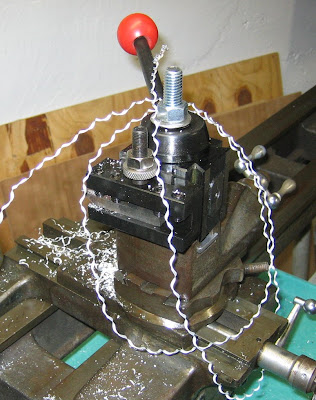Recently I had an electrician install a new sub-panel for my basement shop. The electrician wired in a VFD, an amazing device that converts single phase power to 3-phase power. It lets me control almost anything related to the motor. For example, I configured the VFD so it starts the motor smoothly and will spin up to full speed in about 5 seconds. However, I configured it to stop the motor in 2 seconds. The VFD allows variable speed control without a loss of torque [1/27/13 - probably need a fact-check on this.] It also lets me reverse the motor. Good stuff. Further, the VFD supports a remote control panel so I can control the motor from the front of the lathe and not have to reach my hands in the sub-panel.
Here's the electrical work. The subpanel has breakers for outlets and the VFD. The white device is the VFD. It's about 4" x 4" x 6" and weighs nothing. The control pendant is sitting on the VFD's box. It has a potentiometer for the motor RPMs, an on/off toggle, and a forward/reverse toggle. Underneath the VFD's box, partially seen, is the 3-phase outlet for the motor.

Another advantage of 3-phase motors is that normal people don't want them. The nice Rockwell 1/2hp motor on my lathe was a Craigslist freebie. Gotta love that!
Here's the motor in all it's link-belt glory.

Moving on, the lathe's olde-school (circa 1936) lantern tool post has been "modified" and doesn't function properly. While it's fixable, I only have 2 of the special holders this tool post needs and they're expensive. So I replaced it entirely with a modern quick change tool post. It's a lovely thing. A quick change tool post set includes one toolpost and numerous holders. Cutting bits are secured in holders by Allen screws. The holders slide onto dovetails milled into the tool post and are locked in place when a lever is turned. It takes about 3 seconds to put a new tool in the tool post. Here's a picture of the new toolpost and an inaugural 5-foot long shaving.




